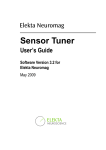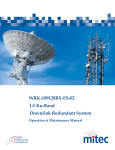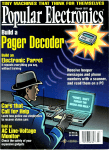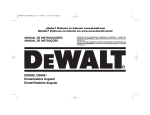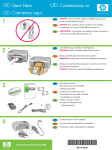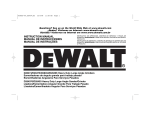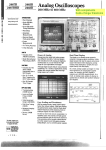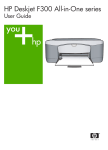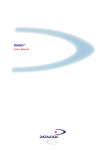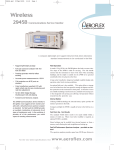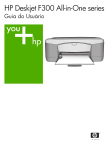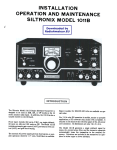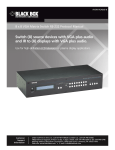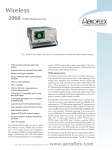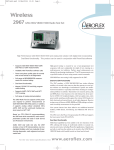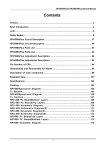Download Aeroflex-IFR-Marconi 2955B Datasheet
Transcript
Test Equipment Solutions Datasheet Test Equipment Solutions Ltd specialise in the second user sale, rental and distribution of quality test & measurement (T&M) equipment. We stock all major equipment types such as spectrum analyzers, signal generators, oscilloscopes, power meters, logic analysers etc from all the major suppliers such as Agilent, Tektronix, Anritsu and Rohde & Schwarz. We are focused at the professional end of the marketplace, primarily working with customers for whom high performance, quality and service are key, whilst realising the cost savings that second user equipment offers. As such, we fully test & refurbish equipment in our in-house, traceable Lab. Items are supplied with manuals, accessories and typically a full no-quibble 2 year warranty. Our staff have extensive backgrounds in T&M, totalling over 150 years of combined experience, which enables us to deliver industry-leading service and support. We endeavour to be customer focused in every way right down to the detail, such as offering free delivery on sales, covering the cost of warranty returns BOTH ways (plus supplying a loan unit, if available) and supplying a free business tool with every order. As well as the headline benefit of cost saving, second user offers shorter lead times, higher reliability and multivendor solutions. Rental, of course, is ideal for shorter term needs and offers fast delivery, flexibility, try-before-you-buy, zero capital expenditure, lower risk and off balance sheet accounting. Both second user and rental improve the key business measure of Return On Capital Employed. We are based near Heathrow Airport in the UK from where we supply test equipment worldwide. Our facility incorporates Sales, Support, Admin, Logistics and our own in-house Lab. All products supplied by Test Equipment Solutions include: - No-quibble parts & labour warranty (we provide transport for UK mainland addresses). - Free loan equipment during warranty repair, if available. - Full electrical, mechanical and safety refurbishment in our in-house Lab. - Certificate of Conformance (calibration available on request). - Manuals and accessories required for normal operation. - Free insured delivery to your UK mainland address (sales). - Support from our team of seasoned Test & Measurement engineers. - ISO9001 quality assurance. Test equipment Solutions Ltd Unit 8 Elder Way Waterside Drive Langley Berkshire SL3 6EP T: +44 (0)1753 596000 F: +44 (0)1753 596001 Email: [email protected] Web: www.TestEquipmentHQ.com ~ 29558 and highlights the function accessed in reverse video. This informs the operator which frequency or level parameter is then available for control. ONTROL " A ,,-, ...'~i.L"'",-,\"Mc:,,;":.' (' . Comprehensive testingfacilitiesfor Af-ll/FM/0M transceivers to 1000MHz . Fullduplexfacilitytestsradio telephonesandcross-band repeaters . Sensitive receiver for off-air transmitter monitoring with option 001 . Built-inself test andoperatorguide . Systemcheckingof simplex transceiversin lessthan3 seconds . OperationfromanystandardACsupply upto 400Hzor vehiclesupply . Sequentialandrevertivetones,DTMF andDCSencoders/decoders . Digital scopewith single shot for peak modulation setting . Menu driven CRTdisplay with 26 stores for recall of standard settings . GPIB or RS232 for full instrument . Precisiondigitalreadoutsandautorangingbarchartsfor rapidtesting The 29558 Radio Communications Test Set combines all the instruments required for transceiver testing within a single unit. Designed for bench and mobile field service applications in maintenance workshops, the instrument is lightweight, portable and may be operated from all standard AC supplies, or vehicle supplies. Comprehensive facilities are provided for testing all types of AM, FM and 0M mobile radio equipment, including low-power hand portables and mobiles using selective calling, full duplex radio telephones, digital pocket pagers, base station and repeater equipment. Major users include mobile radio manufacturers, providers of mobile radio telephone networks, service maintenance workshops, commercial and public service organisations, and the military. Comprehensive Measurements The 29558 comprises 19 instrument functions for transceiver testing: RF power meter, RF frequency meter, modulation meter, RF signal generator, dual AF signal generators, AF frequency meter, AF volt- meter, 1 kHz AF distortion meter, SIN 74 . control HighstabilityOCXO fittedas standard and SINAO meter, sequential tones encoder/decoder, OTMF encoder/decoder, digitally coded squelch (OGS) encoder/decoder, POGSAG digital pager encoder and digital oscilloscope. This comprehensive instrument also functions well as a low-cost ATE system, or as a set of general-purpose test equipment for production, service or laboratory use. With option 001 the 29558 provides a sensitive, selective input for measurement of signals as low as 1 j1V. Simple Set-up Operation of the test set is by keys, which configure the instrument functions to test either a transmitter and receiver together in full duplex mode, or independently for simplex or semi-duplex operation. A large GRT display provides the operator with all generated and measured information relating to a particular test, and a direct indication of controls in use. Setting up the instrument for a particular test involves selection of the appropriate colour identified keys in a logicalleft-to-right sequence. As the operator selects the required keys, the screen indicates the test mode selected """ 1"" \":!'* Setting of specific test channel frequencies, modulating levels and output levels etc. is via a numeric key pad. However, for convenience and speed of operation, three variable controls are provided. Programmable incremental keys for frequency and level allow the operator to define any INC/DECrement size within the range and resolution of the test set. This facility enables rapid channel stepping for checking of multi-channel radios, and simplifies receiver bandwidth and AGC testing. For tests requiring fine adjustments of frequency or level, such as squelch threshold measurements or sub-audible tone deviation settings, a rotary variable control is available. Large Clear Display The CRT display provides the flexibility for measurements to be presented in digital form for precise unambiguous readings, from which a hard-copy printout can be obtained. It also allows measured information to be presented in analog bar chart form, which is convenient for providing adjustments such as simple peaking indications. Comparative measurements between positive and negative peak deviation are available to check modulation symmetry. In transmitter, receiver and audio test modes, a digital storage oscilloscope facility is provided. When testing transmitters, the oscilloscope's vertical scale is directly calibrated for modulation measurements: a single shot facility allows the user to measure peak-to-peak modulation. This peak hold function is invaluable for setting the modulation limiter circuits in the radio, and for ensuring that maximum permissible deviation is not exceeded. TRANSMITTER TEST (MODE 'co Tx TEST) When measuring a transmitter in the frequency range 1.5 MHz to 1000 MHz, the ~ 29558 modulation meter automatically tunes to the incoming signal frequency in typically less than 3 seconds, providing the user with analog and digital readouts of all parameters. This avoids the operator having to set up the transmitter frequency. The screen indicates transmitter frequency, power. modulation frequency, modulation level and transmitter distortion. All measurement scales are auto-ranging, thus preventing the likelihood of accidental damage due to excessive input levels. Best instrument measurement accuracy is assured because manual range selection is avoided: a range hold is available where automatic ranging is not required. These facilities cut service test time dramatically. 150 W Power Handling RF power measurement range is 0.05 mW to 75 W continuous rating, catering for low-power portables and base station transmitters. Power readings in dBm or Watts are available. High-power transmitters of up to 150 W may be measured for short intervals. A thermal sensor warns the operator if the load gets too hot by flashing a screen message to REMOVE RF INPUT. A short interval later an additional two-tone audible alarm is given in case the operator's attention has been diverted from the screen. To facilitate a number of maximum power measurements, without having to wait for the power load to cool, a HOLD DISPLAY key is provided. This enables the user to freeze the entire screen display after the readings have stabilized, allowing all the transmitter measurements and settings to be read, with the transmitter de-keyed. A hard-copy printout of all the digital information contained in Rx, Tx, DUPLEX, AF TEST and Directional Power meter screens can be obtained using a GPIB or RS232 printer. The optional 24 column ticket printer fits into the instrument lid for storage. sse Testing RF frequency counter resolution is selectable as either 1 Hz or 10Hz enabling tests of SSB systems. A two-tone modulating signal may be applied to a SSB transmitter to check for linearity; the carrier waveform may be observed at the IF output socket on the rear of the instrument. This facility also allows future expansion in capability to meet the needs of emerging radio telephone networks. Testing simplex radios is simplified by using the Rx = Tx key. This pre-sets the RF signal generator to the same frequency as the transmitter, saving the operator the task of entering the channel frequency in receive test mode. The INC/DEC keys may be used to offset the generator frequency for channel-to-channel operation or for semi-duplex tests. DUPLEX TEST i~~ODE " D!~IPLEY: TEf:;T) Full duplex testing of radio telephones is possible with all necessary parameters for both the transmitter and receiver displayed simultaneously on the CRT screen. The frequency and level of the RF and AF signal generators may be independently controlled from the instrument key pad or varied using the rotary control. Any Duplex Offset A standard feature is that the modulation meter is independent of the RF signal generator, so there is no restriction to the total frequency offset between transmitter and receiver test. This means that in addition to measuring standard duplex systems, cross-band repeaters and repeater systems using mixed AM and FM equipment can be tested. RECE!VER TEST (MODE"" Ax TEST) In the receiver test mode, standard default settings of the RF and AF signal generators are provided. The RF signal generator level is set to -100 dBm and the AF signal generator frequency to 1 kHz. Modulation can be set to any default value for FM, 0M and AM testing within the default limits. This facility is provided so that the minimum amount of user interaction is required to perform a simple system check after switch on. If the RF signal generator frequency has been preset using the RX= TX key and the radio being tested is simplex, then no further instrument settings are required. For a functioning receiver, audio output will be present from the receiver under test. Noise and Distortion Dedicated keys allow the user to select either signal-to-noise (S/N) , SINAD or distortion test. All readings are displayed numerically on the CRT screen and as auto-ranging bar charts for maximum user convenience. RF output level accuracy is specified to be within :t2 dB over the attenuator range of +5 dBm to -127 dBm, and includes the effects of temperature, from 0 to +50°C, making the signal generator one of the most accurate available in a test set for the maintenance user. Comprehensive modulation control is provided by using the INC/DECrement keys or rotary control. The generator may be internally or externally modulated to produce AM, FM or 0M signals. The external modulation input can be used for dual tone inputs such as DTMF tones, or for FFSK/FSK modulation. AUDIO TEST (MODE = RxTESl FUNCT!ON'" AF GFN) The audio generator function provides access to the 2 audio generators, AF voltmeter and digital oscilloscope. The audio generators provide a choice of sine, square, triangular and saw-tooth waveforms. Tone generation is available providing CCIR, ZVEI, DZVEI, EEA, EIA or USER DEFINED tones, and separately DTMF generation and decoding. The AF input socket has a nominal input impedance of 1 MQ, making it compatible with standard probes. TONES ENCODER'OECCJr!FP The 29558 provides a very comprehensive analog and digital tones encoder/decoder facility for testing selective circuits in mobile radios and digital pagers. Sequential tone standards are available to the user from a screen menu. In addition, a USER DEFINED mode allows 15 different tone frequencies to be defined. Provision is made to send a sequence of up to 33 tones in any standard, either as a single burst, tone step or as continuous cycles for receiver testing. Frequencies may be shifted from nominal up to :t9% in 1% steps for tolerance checking of receiver decoders. Anyone of the sequence tones can be extended. Sub audible tones (CTCSS) and two tone operation are also available. Standard Tones Decoded tones are compared with standard frequencies held in memory. If each tone is within the standard limits, the tone number, frequency and percentage error is displayed. Sub audible tones are measured directly in the transmitter test mode by the audio frequency counter with the 300 Hz low pass filter selected: this allows measurement even in the presence of modulation. For applications requiring encoding and decoding of complex or non standard tones systems, an EXTernal MODulation input and AF DEMODulation output are provided. Revertive tone systems can be tested. Up to 11 tones can be programmed for transmit; with decoding and display of up to 11 revertive tones from the unit under test. 7~ ~ --~~:J_~ - '!~.~1 29558 Using the microphone interface dissipated in the power load, and if a accessory and microphone (54432-013E transmitter with an output power of up to and 54412-020Y) it is possible to use 50 W is accidentally connected to the the 29558 in a 'talk-through' mode as a BNC-RF connector, a relay opens the low power transceiver for testing mobile signal path thus protecting the instrument. equipment whilst in service. This allows instructions to be given to the radio Simple Servicing operator and for comments to be returned. A built-in self test facility identifies faulty In this way large fleets can be quickly sections either to major module level or group of components, so reducing the tested, with minimum disruption to users. The sensitive receiver allows channel mean time to repair. Instrument down-time Pager Testing and frequency scanning. It is possible to is further reduced by modular construction, POCSAG digitally coded pagers can be which simplifies the service of faulty tested with control of the pager frequency, store up to 11 spot frequencies or a modules. The Test Set has only six PCBs channel plan of up to 9999 channels in bit rate, deviation and identity code. plugging into a mother board, a plug-in RF Transmission of either an alert signal only, memory. The 29558 may then be asked to tray, an attenuator block, a receiver module scan until a signal large enough to lift the a numeric message or an alpha-numeric (option 001) and a power load. These are message is available. A facility to insert squelch is found. This is particularly useful easily removed for replacement or further errors into the 32 bit address to test the where a base station is monitored. --test. unit's error correction capability is provided. DTMF messages can be sent and received, and displayed on the screen. Digitally coded squelch (DCS) can be generated with the capability to program the DCS 3 digit code, digital bit rate, modulation level and signal polarity. DCS transmissions can be received, decoded and the waveforms displayed with the correct code highlighted from all possible codes. ?:.~!J!':.r l'l:""!.L!1t!!! 'In "O"F TITLE ~ ~O"EO OF; With option 001 fitted, off-air measure- 81 0" "E""ULl 820" [)EF"ULT ments of a transmitter station can be made by the 2955B when Tx MONitor mode is selected. A selective, sensitive receiver with 1 /.lV sensitivity covering the range 100 kHz to 1 GHz is available to demodulate an off-air signal. Calibrated signal strength is displayed in /.lV, mY, dBfJV or dBm up to a level of 140 mY. Carrier frequency is measured and displayed as an offset from the ideal. Modulation level, frequency and distortion are also displayed, both as readings and as bar charts. 830" 84 H" DEFAULT DEF"ULT [oEF"ULT "CFAOJLT DEF"ULI Dcr"ULT Off-Air Testing In use the 2955B is connected to a suitable antenna or the telescopic antenna supplied. The readings are then presented in a similar way to the normal transmitter test screen. The increment keys may be used to alter the carrier frequency, such as for channel steps, and the variable control is available for fine tuning. The audio generators are available for exciting the transmitter, typically over a land line to a remote base station. Other applications include the use of a probe (see 52388-9000) for fault finding and aligning receiver circuits such as mixers, IF amplifiers and filters. Being high impedance, the loading on the circuit in question can be minimized. The demodulated signal can be monitored on the built-in loudspeaker and on the storage oscilloscope display. If desired an external loudspeaker or a headset can also be used. To cater for different modulation types, two receiver bandwidths are available, 12 kHz for narrowband speech and 180 kHz for data and broadcast signals. The normal transmitter tones decoding facilities are available to permit tests on remote base station calling tones. 76 ",. 0" 060" 010" 88 H" 5TOOE5CDEFCHI.JKL"NOPQRST"l VW"Y281234a.789/-.a!-J I~~ I ~:r_T.!!~ r;ii~ -~~.:~ r;;Tr p-,:- Routine calibration needs have been kept to a minimum and calibration factors stored in non-volatile memory may be accessed with a secure access code from the front panel key buttC'ns, or via the GP!B, permitting rapid recalibration. A 3 ye..;. l..lconditi;:'llal warranty is provided in many territories. -1.;:';'- ~ = ~"T~ 26 non-volatile ~tores are provided, each capable .]1 . dtaining indefinitely a complete front panel set-up, with instant recall whenever required. Each store may be allocated an alphanumeric title of up to 20 characters to remember its contents. One additional storage location (00) provides power fail back-up so that the last group of front panel settings is restored after an AC power or battery supply failure. A facility is provided to lock the stores to prevent accidental erasure. Full instrument control is provided via the GPIB or RS232 interfaces, and adds further versatility for automatic testing, and computer-assisted manual testing. A writeto-screen capability enables the CRT to be used for operator instructions and for simple straight line graphics. Specification tests can be carried out using the upper half of the screen, whilst the lower half is used for drawing limit bar charts and writing text. Instrument lifetime is a significant factor in cost-of-ownership, and the 29558 includes a number of features to reduce calibration costs, reduce down-time and help eliminate expensive repairs. Visual and audible warnings are given when excess power is Accessories are available to provide comprehensive cellular radio test facilities for NMT, AMPS and TAGS. MPT 1327 (Band Ill) and similar trunked radio system test facilities are also available. Other accessories are described later in this document. FREQUENCY Range 0.4 MHz to 1000 MHz (usableto 1060 MHz) Resolution 50 Hz up to 530 MHz. 100 Hz up to 1000 MHz. Indication 9 digit display. Accuracy As internalstandard. OUTPUT LEVEL Range Rx Mode: -135 dam to -15 dam (O.04jJVto 40 mV), N-type socket selected.-15 dam to 5 dam (0.4jJV to 400 mV), BNC socket selected. One Port Duplex Mode: -140dBmto-21.5dBm, (0.0224jJV to 18.85mV). Two Port Duplex Mode: -115 dam to -15 dam (O.04jJVto 40 mV). Resolution 01 dB. Indication 4 digits with unitsjJV, mV, dam, dBliV. PO/EMFselectionas appropriate. Accuracy :,=1.8dB for levels above -127 dam, from +18 to +28'C. :t2 dB from 0 to 50'C 29558 SPECTRAL PURITY Residual FM Lessthan13 Hz rms up to 520 MHz, typically 10 Hz; lessthan26 Hz up to 1000 MHz,typically 20 Hz. (300Hzto 3.4 kHz bandwidth). Modulation range 0 to 10 fads. Level Response Resolution 0.025 rads. up to 63 rads. 01 fads, above 6.3 rads Image Response 0 dB at :t428 MHz of RF input. Typically:t3 Squelch A manual squelch control is provided with a variable threshold Residual AM Lessthan0.5%(300 Hz to 3.4 kHz bandwidth). Modulation frequency range 300 Hz to 34 kHz Harmonics Lessthan-20 dBc up to 1.5 MHz, -25dBcupto 250 MHz, -20dBcupto 1000 MHz. Accuracy :t8%at1 kHz,:t11%from300Hzt03.4kHz. Sub-harmonics Noneupto 530 MHz, less than -25 dBc to 1000 MHz. Spurioussignals Forcarrierfrequenciesup to B8 MHz: Better than-45 dBc up to 110 MHz, less than -35 dBc above110MHz Forcarrierfrequenciesup to 960 MHz: Lessthan-60 dBc. sse phasenoise at 20 kHz offset Lessthan-110 dBc/Hz up to 500 MHz, less than -104dBc/Hzto 1000 MHz. RFleakage Lessthan0.2 /lV PO generatedin a 50 Q load by a 2-tum25 mm loop as near as 25 mm to the case of the instrument with the output set to less than -40 dBm and theoutputterminatedin a 50 Q sealed load. Protection 50W reversepower trip, automaticallyresets on removal01power input (BNC socket). Visualalarmwarning (REMOVE RFINPUT)and audiblealanmprovidedfor added protection. ~M distortion Less than 20/0at 1 kHz with 5 rads (300 Hz to 34 kHz bandwidth). FREQUENCY EXTERNAL As internal plus: Resolution 1 Hzor 10 Hz to 200 MHz, 10 Hz from 200 MHz to 1000 MHz AM Sensitivity 1 V p-p for 30% AM at 1 kHz:t15%reading:t1%AM. FM Sensitivity 1 V p-p for 5 kHz deviation: :t10% at 1 kHz. Modulation deviation range 0 to 30 kHz ~M Sensitivity 1 V p-p for 5 rads :t12%at1kHz. INPUT WAVEFORM SHAPE Sine, square, triangle, saw-tooth. FREQUENCY Range 10 Hz to 20 kHz. CWrange 15 to 400 MHz, usable from 400 kHz to 500 MHz. Modulationdepth range 0to 99%. Accuracy :to.01 Hz :1:0.1 Hz from from Distortion Less than 50 to Hz 10 100 0.5% 15 Hz to 100 Hz to 20 at 1 kHz kHz Residual AM distortion Lessthan 2% distor1ionat 1 kHz with 30% AM (300 Hz to 34 kHz bandwidth). OUTPUT LEVEL (EMF) CW range 0.4 to 1000 MHz (usableto 1060 MHz). Modulation deviation range 0 to 25 kHz. Frequency range As RF FrequencyMeter. Hz. kHz. (sine), less than 1% from than 0.1 mV RMS in a psophometric bandwidth. offset Less than 10 mV DC Range 0.1 mV to 4.095 0.1 mV to 4095 V RMS V peak (sine and square). (triangle and sawtooth). dig~, 50 Hz to 15 kHz. Setting 0.1 mV steps (0.1 mVto 409.5 Accuracy ~.'%z10Hzat1 kHz. z10% from 50 Hz to 15 kHz. FM distortion Less than 1% distortionat 1 kHz with 5 kHz deviation (300 Hz to 3.4 kHz bandwidth). PHASE MODULATION INTERNAL CW range 0.4 to 1000 MHz. Accuracy :t10% :t1 digit up to 500 MHz, :t15%:t1 digit up to 960 MHz, :t2O%:t1 digit up to 1000 MHz, :t25% typical BNC socket mV). 1 mV steps (409.5 mV to 4.095 V). Resolution 25 Hz «6.25 kHz dev.). 100 Hz «25 kHz dev) Modulation frequency range 20 Hz to 20 kHz Setting Automatic rangingon scales with full scale values 30, 100,300 mW, 1,3,10,30,100 Wand 300 W. VSWR Less than 1.2 to 500 MHz, less than 135 to 1000 MHz (N-type). Less than 2.2 to 1000 MHz (BNC) Accuracy :1:5%:1:1 Resolution 1% full-scale Indication 2/3 digits and analog display. noise Less DC Measurement Units Watts or dBm (sine). Accuracy :;7%of setting :;1 digit at 1 kHz up to 85% AM. :;10%ofsetting:;1 digit, 50 Hz to 5 kHz up to 70% AM. :;15%ofsetting:;1 digit, 50 Hz to 15 kHz up to 85%AM FREQUENCY MODULATION INTERNAL Range 0.05 mWto 150W. Input to type-N socket: 50 mW to 75 W continuous,Tx Mode selected 100 mW to 75 W continuousin single port duplex mode (150 W max for typically 2 minutesat 25°C continuous) End of safe working is indicatedby screen warning "REMOVERF INPUT' and audible alarm. Input to BNC socket: Usable005 mW to 25 mW. Less than 5 Q nominal. Resolution 0.1 Hz (10 Hz to 3.25 kHz). 1 Hz (3.25 kHz to 20 kHz). Modulationfrequency range 20 Hz to 20 kHz INPUT Accuracy As internal standard :t1 digit. VSWR Lessthan 1.2 to 500 MHz, less than 1.3 to 1000MHz (N-type),less than 2.2 to 1000 MHz (BNC). Resolution 10;0. Typical acquisition Up to 200 MHz, 100 ms, with 10Hz resolution; 1 s with 1 Hz resolution Up to 1000 MHz, 400 ms. Sensitivity N type socket; 5 mW (0.5 V), Tx mode selected. 20 mW (1 V), one/two port duplex. BNC input; 0.05 mW (50 mV); 1 jJV with option 001 fined Modulation frequency range 1 Hz to 50 kHz. OUTPUT IMPEDANCE INTERNALAMPLITUDE MODULATION Range 15 MHz to 1000 MHz (usable to 1060 MHz) Input impedance 1 MQ in parallelwith approximately40pF. OUTPUTIMPEDANCE 50Q nominal. MODULATION dB from 10 MHz to 1000 MHz. FREQUENCY Range 100 kHz to 1000 MHz (usable to 1060 MHz). Sensitivity 2/lV for 10 dB SINAD in 12 kHz bandwidth from 1 MHz to 1000 MHz for 3.5 kHz deviation in psophometric bandwidth (typically 1 /lV). Linearity Response Typically:t3 dB level accuracy at 100 MHz with reference to ~ dBm, over range -87 dBm to -24 dBm (10/lVto 14 mV) BNC; -67 dBm to -4 dBm (100/lVto 140 mV) N type. Manual tune Providesfrequency offsetindication fromcarrier. 3 Digits and decimal point indicate most significant positiveor negativeerror. Auto-tune Providesmeasurementand simultaneousdisplay of RF frequency. power, modulationfrequencyand level, and 1 kHz demodulationdistortion. Acquisition Less than 3 seconds at 10 Hz resolution. INPUT Frequency range As RF FrequencyMeter. - A.. - 29558 Sensitivity As RF FrequencyMeter AF filters The followingfilters are available: Bandpass- 300 Hz to 3.4 kHz, Low pass - 300 Hz, Low pass -15 kHz. AMPLITUDE MODULATION CW range 15 MHz to 400 MHz Modulation range Manualtune mode: 0 to 100% up to 400 MHz. Auto-tune mode: 0 to 90% up to 100 MHz. 0 to 80% up to 400 MHz. Auto ranging (bar chart), Oto 10, Oto 30, 0 to 100% depth Accuracy ;;5% :t1 digit at 1 kHz, :t8.5% ;;1 digit from 50 Hz to 10kHz. Resolution 1%AM Modulation frequency range 10Hzt015kHz Demodulation distortion Less than 2% above 21 MHz; Less than 5% below 21 MHz; measuredin a 300 Hz to 3.4 kHz filter and 30% AM at 1 kHz. Residual AM Less than 1% in a 300 Hz to 3.4 kHz bandwidthfor inputs above 10 mW/0.1 mW (N-Type/BNC). FREQUENCY MODULATION Modulation range 0 to 25 kHz Automaticranging (bar chart), 0 to 1,0 to 3, 0 to 10, 0 to 30 kHz. Resolution 10 Hz up to 2.5 kHz deviation 1% up to 25 kHz deviation. Accuracy :t5% :t1 digit at 1 kHz, ;;7.5% over range 50 Hz to 10kHz Modulation frequency range 10Hz to 15kHz. Demodulation distortion Less than 15% at 5 kHz deviation and 1 kHz modulationfrequencyin a 300 Hz to 3.4 kHz bandwidth Residual FM Lessthan 15 Hz RMS up to 500 MHz, typically 12 Hz Less than 30 Hz RMS up to t 000 MHz, typically 24 Hz. For inputs above 20 mW/0.2 mW (N-Type/BNC), (300 Hz to 34 kHz bandwidth). PHASE MODULATION Modulation range 0 to 10 radians Automatic ranging (bar chart), 0 to 1, Ot03andOt010radians. Resolution 1% or 001 radians. Accuracy :,=5%:t1 digit at 1 kHz :t7.5% :t1 digit from 0.3 to 34 kHz with respect to 750 IlS de-emphasis. Modulation frequency range 300 Hz to 34 kHz Phase de-modulation is obtained using 750 IlS de-emphasis. Demodulation distortion Less than 2% at 5 rads Modulated by 1 kHz measured in 300 Hz to 34 kHz bandwidth. Voltage range 10 mV/div to 20 V/div in a 1-2-5 sequence. Sensitivity 50 mV (100 mV for 40 dB SINAD/S/N). Accuracy ;;5%. FM ranges ;;30,15,6,3,1.5 kHz deviationat ;;10% accuracy. Frequency 1 kHz. Range 0 to 10%, 0 to 30% distortion. 0M ranges ;;15,7.5,3,1.5radat;;10%aCCuracy Resolution 0.1% distortion. AM ranges 20, 10, 5%/div at ;;10% accuracy. Accuracy ;;5% of reading ;;0.5% distortion. Sweep rates 100 /ls/div to 5 S/divin 1-2-5 sequence,accuracy lockedto internal standard. Sensitivity 50 mV (100 mV for 1% distortion) Trigger Repetitiveor single-shotstorage Features AC + DC, or AC measurements. Input impedance 1 M(1 in parallel with approximately 40 pF. Frequency range 20 Hz to 50 kHz (or DC) Level range 0 to 100 mV, Oto 300 mV, Oto 1, Ot03, Oto 10, Oto30 andOt0100V. Tone decoder facilities Displaystone number,frequencyand percentageerror. Screen indicatesnull tones (using CRT) and annotates out of limit frequenciesfor ease of identification. Resolution 1 mV on 1% dependent on range Accuracy :t3% :t3 mV :t1 digit (50 Hz to 20 kHz or DC). Frequency response Switchable: bandpass 03 to 3.4 kHz, low pass 300 Hz or 50 kHz, external filter Range 20 Hz to 20 kHz Tonesencodeanddecodefacilityavailableusing AFGEN output and AF input 8NC sockets Accuracy As internal standard :t1 digit :to.1 Hz or 0.02% (whicheveris greater). Revertive tones Available in Receive Test Mode, tones are sent to the radio and the 29558 awaits a response. Sensitivity 50mV. .;':j~~LI~~~:.,.. DTMF ENCODER/DECODER Provides DTMF encoder and decoder under Tones menu. Tone duration and intertone gaps may be varied from 10 to 999 ms in 1 ms steps. ~,:ijr:.1lJ~jr,-1;.:: OCXO Oven controlledcrystal oscillator, nominalfrequency 10 MHz. Temperature coefficient Less than :t5 pans in 10' from 0 to 50.C; Less than :t4 parts in 1o'rc from 50 to 70.C. Ageing rate Less than :t5 pans in 10"/month,:t2 pans in 10'/year after 1 month's continuoususe Short-term stability Less than :t1 pan in 10', RMS frequency error over a 1 s period. Retrace error Less than :t2 parts in 10' over 24 hours, at constant temperatureand after 25 minuteswarm-up '~I..,~~T,1. -~;ll":!-~cl~~~:,.,.j;-:.ir,1i~',W;1': ~~,I;II Frequency 1 MHz Level 100 mVt03 V AMS. Impedance Nominally 10 k~l in parallel with 100 pF. Frequency 1 kHz Range 0 to 18 dB, 0 to 50 dB (SINAD). Oto 30. 010 100 dB (SIN). Resolution 01 dB. Accuracy :t1 dB. 78 User defined Allows definitionof up to 15 tones. Frequencyrange 300 Hz to 34 kHz, duration 20 ms to 1.2 s (decode);20 Hz to 20 kHz, duration 10 ms to 999 ms (encode).Frequenciesare stored in nonvolatile memory A copy function allows any of the tonestandards to becopiedthenmodifiedinthe user defined memory Tones in audio mode Resolution 0 1 Hz/1 Hz. 'JI~r;il!,-1. Functions Encodes33 tones, decodes up to 33 tones in a CCIR, ZVEI, DZVEI, EEA, EIA or USER DEFINEDtone sequence. Tone encoder facilities Send continuous,burst, single step, extend any tone, null, repeat or frequency shift up to ~9% in 1% steps. ,.~I,c:Ilr,1~ ;-:ii~.:;lr,.1,c:~[~;,-j,.,~..,.];-:~.,~.~~i' PAGER TESTER Encoding of POCSAG code CCIR No 1 Rec. 584. Bit rate 400-1500 bits/s, deviation 0-25 kHz Allows entry of Radio Identity Code (RIC), 4 addresses, 2 preset numeric messages, 4 alphanumeric messages and insertion of bit errors. A data Invert facility is provided. DCSENCODER Digitally Coded Squelch encoder, allows entry of Bit rate 100-200 bits/s, deviation 0-25 kHz. Polarity, normal or inverted, RIG 3 digit code. DCS DECODER Displays bit rate, deviation, polarity and all possible codes. DEMODULATION OUTPUT SOCKET Level 400 mV p-pfor;:1 kHz deviation ;:10%. Impedance 10 k~1 nominal. Bandwidth Features Single or repetitive sweep. available in Tx, Ax and Audio Test modes (Tx MON with option 001), calibrated for AM. FM and 0M Frequency range DC to 50 kHz (from 3 Hz on AC). Either 300-34 kHz, 15 kHz or 300 Hz LP EXTERNAL MODULATION In Rx MOD, the 2955B can be configured to measure the modulation at the EXT MOD INPUT Adjustment will provide the desired modulation level. 29558 ACCESSORY SOCKET Pins3, 4, 5, 6 accessorycontrol. Pin2, +12V, 100 mA max Pin7,AF output,1 W into 8 t~. Pin1,pulseou1pu1 availableunder GPIB control, approximately 600 ns. Rx = Tx FREQ Presets the RF signal generator frequency to the measuredfrequency in Tx mode and Duplex mode. Hold Display Freezes instrument settings and readings, facil~ting high RF power measurements and hard copy printout of Tx, Ax, Duplex, Tx monitor or AF test screens. J i i , ,i 1 ~ INC/DEC Available in Tx, Ax, Duplex, Tx monitor and AF test modesfor defining frequency or level increments of the AF and RF signal generators. Any step size setting within the range and resolution of the test set is pem1issible Supply frequency 45 Hz-440 Hz Maximum consumption 100 VA (with all options fitted). DC supply consumption Less than 70 W (with all options fitted). GPIB INTERFACE All functions except the supply switch are remotely programmable. RATED RANGE OF USE 0 to 50.C Audible output For listening to demodulated output and received audio. Two tone modulation In transmit mode, two tones are available under tones menu in receiver mode, external modulation inputs add to internal modulation - Supplied with AC Supply Lead Operating Manual. Introductory Guide. DC Supply Lead (with option 006). BNC Telescopic Antenna (with option 001). Operating Summary Card. RADIO FREQUENCY INTERFERENCE Conforms with the requirements of EEC Directive 76/889 as to limits of RF interference. Complies with VDE 0871, limit value Class B, as specified in General Licence Vfg 1046/1964. Recall00 Hold range The displayed bar chart can be held, ie no autoranging, by use of the oscilloscope pushbuttons. Versions Radio CommunicationTest Set with GPIB interface. Option 001 Sensitivereceiver. Option 002 GPIB interface removed. Option 003 RS-232fitted in place of GPIB interface. Option 004 FrenchVersion. Option OOS SpanishVersion Option 006 DC Kit & Front StowageCover. Capabilities Complies with the following subsets as defined in IEEE 488-1978 and IEC Publication 625-1: SH1, AH1, T5, L4, SR1, RL1, PPO, DT1, E1. SAFETY Complies with IEC 348. Approved to UL 1244. Help Provides access to SELF TEST, stores lock, RF meter resolution, SINAD or SIN default values, external attenuator offset, variable default deviation, 2955/NORMAL emulation, default AF filter, Rx/Tx modulation type lock, USNEurope tone standard selection, and user help for Tx, Rx, Duplex and AF test modes Ordering Numbers 29558 DC supply voltage 11-32 V DC Store/Recall 26 non-volatile stores (01 to 26) are provided, each capable of retaining all front panel settings for up to 10 years Alphanumeric titles are available for all store locations An additional store (00) is provided to retain the last test set-up, in the event of a power fail. VERSIONS AND ACCESSORIES When ordering please quote eight digit code numbers. range Selected Accessories Cellular and Trunking UMIT RANGE 0 to 55.C OF OPERATION CONDITIONS OF STORAGE AND TRANSPORT Temperature -40 to +70.C 54415-0205 NMT Cellular Software' TACS Cellular Software' Band III (MPT 1327) Trunked Radio Software' * Fits into one of the above Humidity Up to 90% humidity. Altitude Up to 2500 m (pressurized freight at 27 kPa differential, i.e. 39 Ibf/in'). DIMENSIONS AND WEIGHT Height Width Depth 175mm 345mm 460mm 6.9in 13.6 in 18.1 in Weight 15.5 kg (34lb) 16.8 kg (37Ib) with all options fitted. 54415-018W 54415-019D i converts a 2955B with GPIB to 2960B to allow Cellular & Trunking. NMT Cellular Software' AMPS Cellular Software' TACS Cellular Software' Band III (MPT 1327) Trunked* Radio Software I Multi-cellular and trunking adapter including D-AMPS, converts a 2955B with GPIB to 2960D to allow Analog Cellular and Trunking + D-AMPS. 46884-581G 46884-5835 46884-585D I adapters; at least one must be selected at time of ordering. Analog Amps Adapter - converts a ~955B with GPIB to 2957B to allow Analog AMPS Cellular. Digital Amps Adapter - converts a 2955B with GPIB to 2957D to allow Analog and Digital AMPS Cellular I General Accessories 54421-003J 54421-002L 54462-o23W POWER REQUIREMENTS Rated supply voltage 105-120 VAG, 210-240 V AG, all :t100/o. Multi-cellularand trunking adapter, 5441S-01SG 46884-101J 46884-102F 46884-103G 46884-1055 1 Adapters: 54211-001D 46883-877P 54433-002Y 54433-D04L 44991-1295 54411-0S2M 54499-042L 54499-043J 41690-60SY 46662-192W 54412-157G 46882-1148 RF DirectionalPower Head 25 MHz-1000 MHz RF Directional Power Head 1 MHz-50 MHz Battery Pack with built-in DC input fast charger. Printer 24 Column with Paper & Ribbon. Printer Ribbon & Paper Kit. GPIB Interface. RS-232 Interface. PMRTEST Software 600 Q Balanced Interface with 20 dB Attenuator. CCITT Psophometric Filter. CMESS PsophometriC Filter Front Stowage Cover. Hard Transit Case for 2955, 2957 and 2960 series. Soft Carrying Case for 2955 series Service Manual. For further details of accessories please refer to the 2955 Series Accessories data sheet. 79








